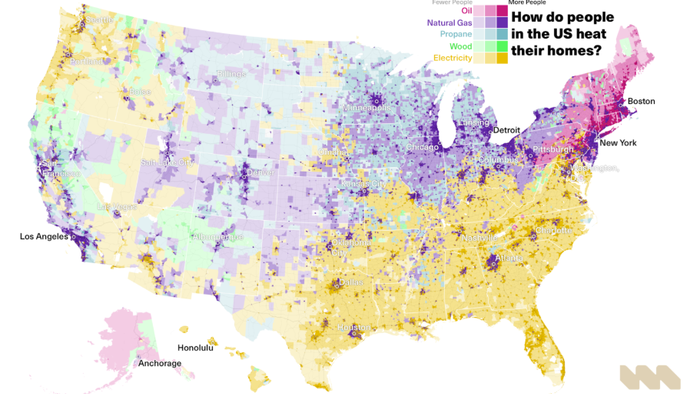Heating homes in the United States involves a diverse range of energy sources including natural gas, oil, propane, electricity, wood, and geothermal energy, among others. Joshua Stevens, a cartographic editor at Maps.com, has shed light on the geographical distribution of these heating methods across the Lower 48 states in a recent note. According to Stevens, the choice of fuel for heating homes largely depends on the geographic region due to factors such as availability, climate, and infrastructure. He points out that more specific regional patterns can be identified, where the Northeast and Alaska rely heavily on oil for heating, the Southeast predominantly uses electricity, while the Midwest sees a mix of propane and natural gas as primary heating sources. Additionally, the western regions tend to have higher instances of homes using wood as a heat source.
Stevens delves deeper into how geography affects heating methods by underscoring the importance of urban density. In urban areas, there is often a significant difference in the types of heating fuels used when compared to rural areas. Natural gas emerges as a common fuel in urban settings due to the ecological efficiencies resulting from dense housing. Installation of natural gas pipelines requires significant infrastructure investment, which is primarily viable in residential areas where homes are close together. This makes natural gas less feasible in sparsely populated regions that have historically relied on other fuel types. Conversely, in densely populated cities and suburbs, the proliferation of homes allows for more efficient service through a lesser number of pipeline lines, driving a preference for natural gas in those locales.
The regional heating strategies also reflect broader economic and political dynamics. Though urban areas have a substantial reliance on natural gas, these communities often show a preference for alternative energy sources, which can contrast sharply with rural areas that might favor more traditional heating fuels. This dichotomy has raised interest among political scientists who recognize that urban dwellers tend to have different voting patterns and energy preferences than those in rural settings. The complexities of revamping urban heating strategies to accommodate alternative fuels will be challenging, requiring both financial investment and considerable time, which complicates the transition in an already established infrastructure.
As climate activists actively push to transition away from fossil fuel-based heating methods, a map showcasing the prevailing use of fossil fuels for heating in various regions serves as a stark reminder of the current reliance on these sources. This situation is particularly ironic given that even if homes were to shift toward electric heating, the power supplied to these electrical systems often still originates from natural gas power generators. This creates a dilemma that highlights the interconnectedness of the energy sector and the challenges it faces in transitioning to greener alternatives. While the push for more sustainable energy uses is driven by broad support among both the populace and policymakers, the practical realities of energy supply mean that much of the power on current grids is still generated from fossil fuels.
Transitioning away from natural gas heating systems, as urged by far-left climate activists, requires a rethinking of the entire energy framework in cities and rural areas alike. Policymakers must consider the realities of infrastructural limitations, historical dependencies on certain types of heating fuels, and the economic factors that influence what energy sources are most viable. A combination of technological advancements and regional considerations will play a critical role in how heating methods evolve in the coming years. The complexities of geographical differences, combined with public sentiment around energy use, will significantly shape the future of heating practices throughout the country.
In summary, the variety of heating methods utilized in American homes reflects a complex interplay of geographical, economic, and political factors. Joshua Stevens’ analysis reveals that different regions have specialized reliance on specific fuel sources, with natural gas often dominating in urban areas due to their infrastructure advantages. As climate discussions intensify, the transition to alternative energy sources faces considerable challenges and requires a thoughtful approach that considers both the geographical diversity of heating practices and the existing economic frameworks. This ongoing dialogue will necessitate collaboration between stakeholders to establish a more sustainable energy future while balancing the needs and realities of diverse communities across the nation.

